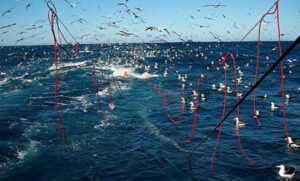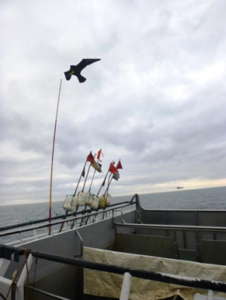Bird-Scaring Lines
WHAT ARE BIRD-SCARING LINES?
Bird-scaring lines (also known as streamer lines or tori lines) are an effective method for significantly reducing seabird bycatch in longline and trawl fisheries. Simple and economical, bird-scaring lines are towed from the stern of the vessel, over the area where – in the case of longlines – baited hooks are deployed.
Brightly coloured streamers attached to the backbone of the line act as a ‘scarecrow’, keeping birds from getting tangled in the baited hooks. A towed object is attached at the end of the line to create additional drag and stabilise the line in high winds. Bird-scaring lines should be deployed before the fishing gear is shot-away, and reeled back once the final hook has been set.
Using two lines together is considered best practice (see image). Additionally, it has been suggested that bird-scaring lines are to be used in combination with weighted branchlines (ensuring hooks sink rapidly) and night setting (avoiding peak seabird activity) to maximise bycatch reduction. Bird-scaring lines placed so that they discourage seabirds from getting near to warp cables – the cables used to tow nets – have been shown to be particularly effective in preventing seabird-gear interactions.

Source: ACAP
CURRENT RESEARCH & USE
In 2004/2005, the South African hake trawl fishery was found to result in a significant number of albatross deaths by cable strikes, mostly during the discarding of offal (fish waste). Bird-scaring lines were introduced as a mitigation method, and by 2010, seabird mortality fell by 73-95% compared with 2004. A 2021 study similarly reported a 98.4% reduction in seabird bycatch in Namibian demersal longline hake fisheries.
Having been tried and tested in the above fisheries and others across the world, bird-scaring lines are considered best practice and an effective measure by the Agreement for Conservation of Albatrosses and Petrels (ACAP) to reduce incidental bycatch of seabirds in demersal and pelagic longline fisheries. They are required by law in Namibian and Australian longline fisheries, Argentinian trawl fisheries, Brazilian pelagic longline fisheries, Chilean longline and trawl fisheries, and South African hake trawl, demersal and pelagic longline fisheries. A bird-scaring line electronic monitoring device has also been developed and trialled, with ACAP reporting in August 2024 that the device would shortly be ready for market; this enables automatic detection and monitoring of implementation of bird-scaring lines without the need for human observers. Bird-scaring lines are not yet a legal obligation in UK fisheries, but are growing in popularity due to their simplicity and efficacy.
Another device has been tested in Portuguese artisanal purse seine fisheries called ‘SCARYBIRD’. This has a harrier shape to scare away prey birds and can be affixed either to the fishing vessel or to buoys. Although no mortality related to bycatch events happened during an early trial, the device reduced the presence of gulls by 11%. A second trial in the same region reported a more significant deterrent effect with a 56% reduction in the number of gulls and 72% reduction in the number of gannets coming close to the vessel and gear; this can be expected to reduce bycatch given that the risk is highest when the net is closer to the surface during shooting and hauling events. However, a follow-up study with a bottom set-net fishery in southern Portugal found that the device only reduced the abundance of gulls when used in combination with discard and offal management (although these findings are reported in a pre-print paper, meaning they have not yet been peer-reviewed and may be subject to revision in the future).

Source: ACAP
This page was last updated on 03.07.25.
Interested in how this and other measures could mitigate bycatch in your fishery? Get in touch with us to collaborate or take part in a study.
